The Bengal Tiger also known as Royal Bengal Tiger or Indian Tiger, the only tiger breed in the world that can live in mangroves. But why are they called the Royal Bengal Tigers? And why are these majestic creatures struggling for their existence?
Let’s delve into the world of the Royal Bengal Tiger and answer these questions.
Quick Overview
| Scientific Name | Panthera tigris tigris |
| Name | Bengal Tiger, Indian Tiger and Royal Bengal Tiger |
| Lifespan | 8-10 years (wild), up to 20 years (captivity) |
| Diet | Carnivorous (mainly deer, wild boar, cattle, and goats) |
| Size | Males: 9-10 feet in length, 3-3.5 feet tall at the shoulder, 397-569 pounds. Females: 7.5-8.5 feet in length, 220-350 pounds |
| Habitat | Tropical, subtropical, and temperate forests |
| Conservation Status | Endangered |
| Unique Features | Unique stripe pattern, ability to swim, presence of white and golden variations due to genetic anomalies |
Scientific Classification
The Bengal tiger, initially classified as Felis tigris by Carl Linnaeus in 1758, underwent a significant reclassification in 1929. Reginald Innes Pocock moved it to the Panthera genus, naming it Panthera tigris tigris, with Bengal identified as its traditional type locality.
As scientific understanding evolved, the distinctiveness of several tiger subspecies in continental Asia was debated in 1999. The primary reason was the minimal physical differences among tigers from various regions.
It led to a proposal to recognize only two tiger subspecies: P. t. tigris in mainland Asia and P. t. sondaica in the Greater Sunda Islands.
Further genetic studies revealed that Bengal tigers were distinct from Siberian tigers. In a significant 2017 revision, all tiger populations in continental Asia, both extinct and living, were grouped under P. t. tigris.
| Kingdom | Animalia |
| Phylum | Chordata |
| Subphylum | Vertebrata |
| Class | Mammalia |
| Order | Carnivora |
| Suborder | Feliformia |
| Family | Felidae |
| Genus | Panthera |
| Species | Panthera tigris |
| Sub Species | Panthera tigris tigris |
Size and Appearance
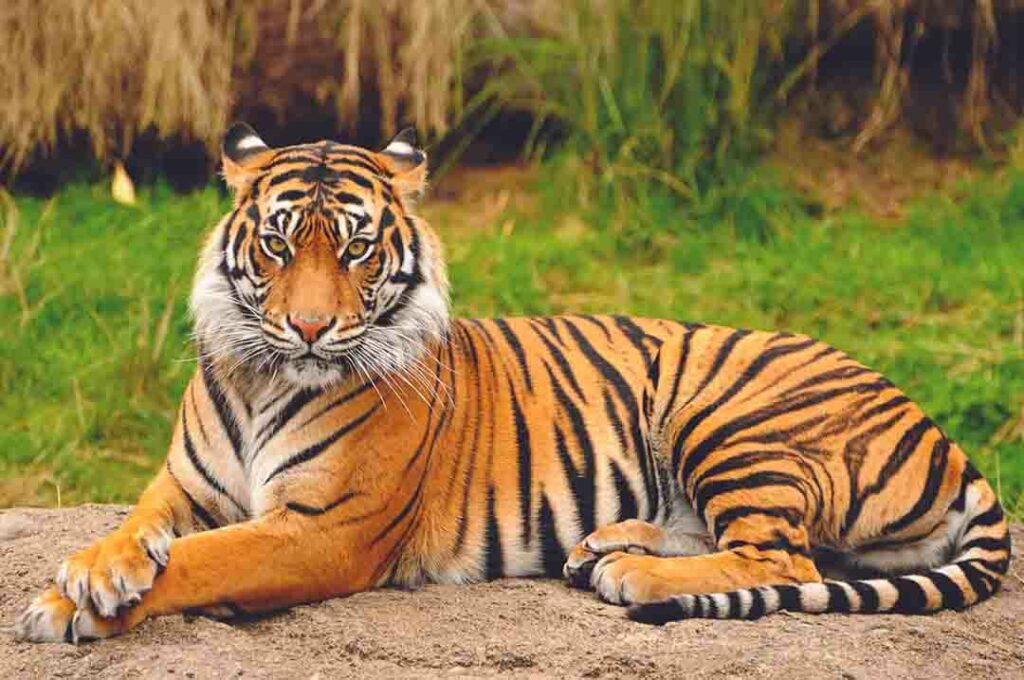
Bengal tigers are the second largest cat species in the world.
A male tiger can grow from 9 to 10 feet in length, attain a height of around 3 to 3.5 feet at the shoulder, and weigh between 397 and 569 pounds.
The females significantly smaller, but still boast a formidable size, with a length ranging from 7.5 to 8.5 feet and a weight ranging between 220 to 350 pounds.
The Bengal tiger’s coat is a visual spectacle. It usually exhibits a radiant yellow to light orange hue, embellished with brown and black stripes. The stripes of each tiger are distinctive, like a human fingerprint.

However, a genetic anomaly can occasionally lead to the birth of a White Bengal tiger. These tigers, identified by their entirely white coat interspersed with brown to black stripes, often outgrow and outweigh the regular tiger.
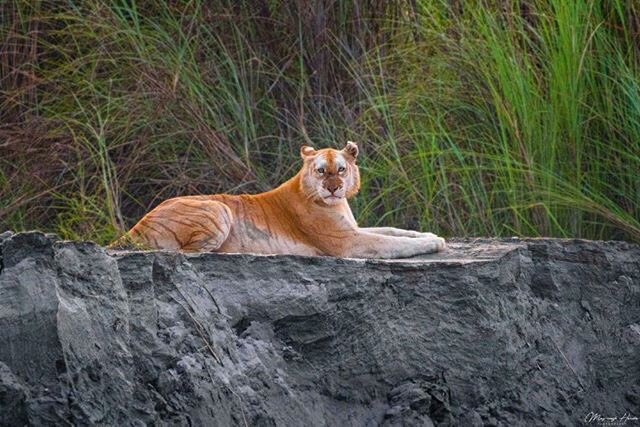
In addition to the white variant, there’s the extremely rare Golden Bengal tiger. This variant, resulting from a unique genetic condition, boasts a lighter golden coat adorned with faint stripes, adding another level of fascination to this majestic species.

Moreover, there have been reports of the elusive Black Bengal tiger, primarily found in the Similipal Tiger Reserve in India. These tigers have a denser pattern of black stripes that often merge, giving them a darker appearance. This unique coloration adds another layer of fascination to the already majestic species.
Reproduction, Offspring, and Longevity

The cycle of life for the Bengal tiger is a fascinating journey. These magnificent creatures mate all year round, with a noticeable spike in births during April and December. After a gestation period of approximately 3.5 months, the female gives birth to a litter that can include up to six cubs.
These newborns, weighing between 1.7 and 3.5 pounds, are born with their senses of sight and hearing not yet developed and are covered in soft fur that they shed between 3.5 and 5 months of age.
The cubs remain under their mother’s care for two to three years, during which the mother does not reproduce. Once the cubs leave, she resumes her reproductive cycle.
In the wilderness, a Bengal tiger can live up to 15 years, while in captivity, their lifespan can extend to 20 to 25 years, barring any unforeseen circumstances or diseases.
Behavior
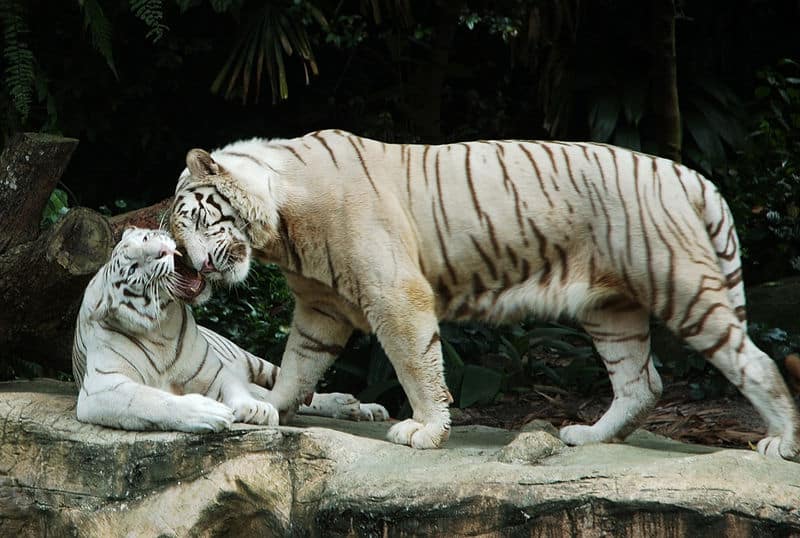
Bengal tigers are primarily solitary creatures, with the mother and her offspring being the primary social unit.
This solitary nature persists beyond the early development period of two to three years.
On rare occasions, when a bountiful food source is available, tigers may gather, forming what is known as an ambush or streak. Bengal tigers are territorial and seldom stray from their home territories. When young tigers venture independently, females usually stay close to their mother’s territory.
During their first year of independence, these adolescent cubs occasionally visit their mothers’ territories, with females doing so more frequently than males.
Diet
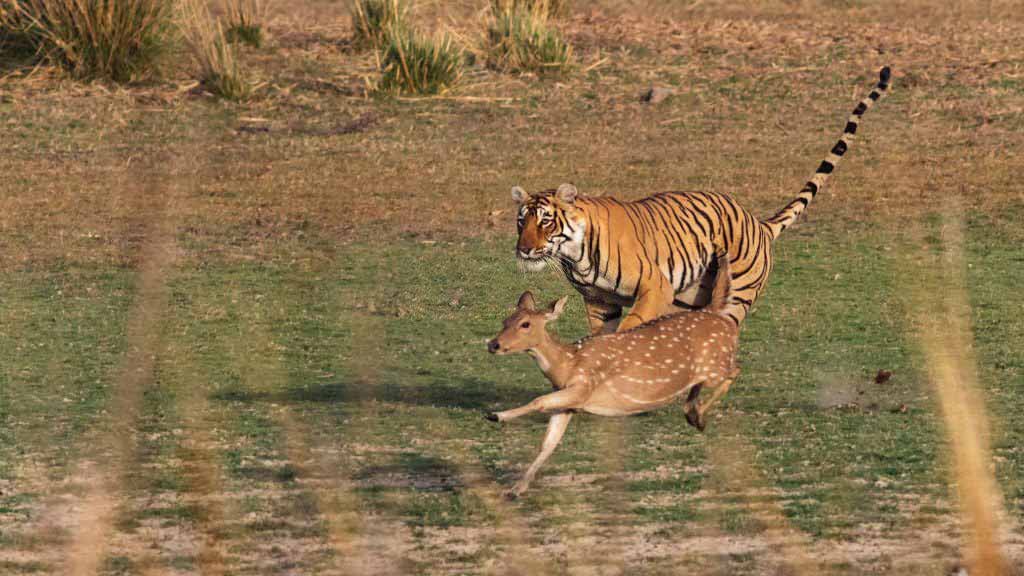
The Bengal tiger is an apex predator that primarily hunts larger mammals. These nocturnal hunters can travel extensive distances searching for prey, including buffalo, deer, wild pigs, and other large mammals. However, their diet can vary significantly based on their habitat and prey availability.
When the opportunity arises, Bengal tigers take down larger prey, such as rhinos and crocodiles. This surprising ability to tackle such larger animals shows their strength and hunting prowess. On the other hand, they also consume smaller animals if larger prey is unavailable, demonstrating their adaptability.
The Bengal tiger’s hunting strategy is a marvel of nature. They use their distinctive coats as camouflage, lying in wait and stalking their prey until they can launch a swift and fatal pounce. A hungry tiger can eat 60 pounds in one night, although they usually eat less.
Despite their fearsome reputation, most Bengal tigers avoid humans. However, a few become dangerous maneaters due to sickness, an inability to hunt usually, or living in an area where their traditional prey has vanished.
One such notorious man-eater was the Champawat Tiger, a female Bengal tiger responsible for an estimated 436 deaths in Nepal and the Kumaon area of India during the last years of the 19th and the early years of the 20th century.
The Bengal tiger’s fascinating diet and hunting behavior testify to its survival skills and adaptability in the wild. Their ability to switch prey and adapt to changing circumstances is a testament to their resilience and a critical factor in survival.
Habitat
Bengal tigers are versatile in their habitat choice, residing in tropical, subtropical, and temperate forests with access to water. They typically inhabit regions between 660 and 9,800 feet above sea level. However, this is changing, as evidenced by a Bengal tiger spotted at 13,800 feet in Bhutan in 2008.
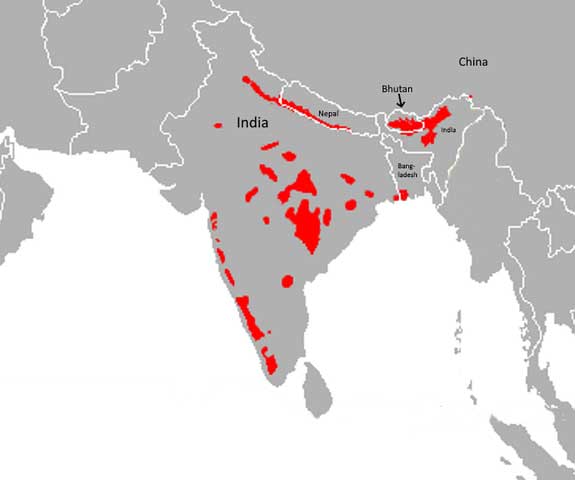
Currently, these tigers are found in India, Bangladesh, Nepal, and Bhutan. They inhabit tropical forests, subtropical deciduous forests, certain grasslands, and mangroves in India. Bangladesh’s population has dwindled, and they are now only found in the Sundarbans mangrove forests and the Chittagong Hill Tracts.
Nepal hosts three small and isolated tiger populations in Chitwan National Park, Parsa National Park, and Bardiya National Park. In Bhutan, Bengal tigers are found in 17 out of the country’s 18 districts.
Why it is called Royal Bengal Tiger?
Perhaps their hunting prowess led the British to give them the title of Royal. When they saw this tiger for the first time, the appearance of Indian tigers, their gait, their royal nature, expertise in hunting, and their fearless nature impressed the European hunters.
The title may have been given by the British, but tigers have been living in India for 12,000 to 16,500 years.
Human-Tiger Coexistence
From ancient times, people have learned to live in harmony with animals. Tigers wouldn’t attack or hunt humans. When travelers passed through jungles, they would carry torches and drums. So humans and animals can continue on their path and don’t cross each other’s paths.
But the situation changed when guns were used for hunting during the Mughal rule. During those days, hunting tigers was considered an act of bravery. And poems were written on tiger hunters.
Hunting and Decline
Then came the British, and their love for hunting started rapidly diminishing the population of tigers. India’s kings, emperors, and rich men would take their European friends into the jungle for hunting.
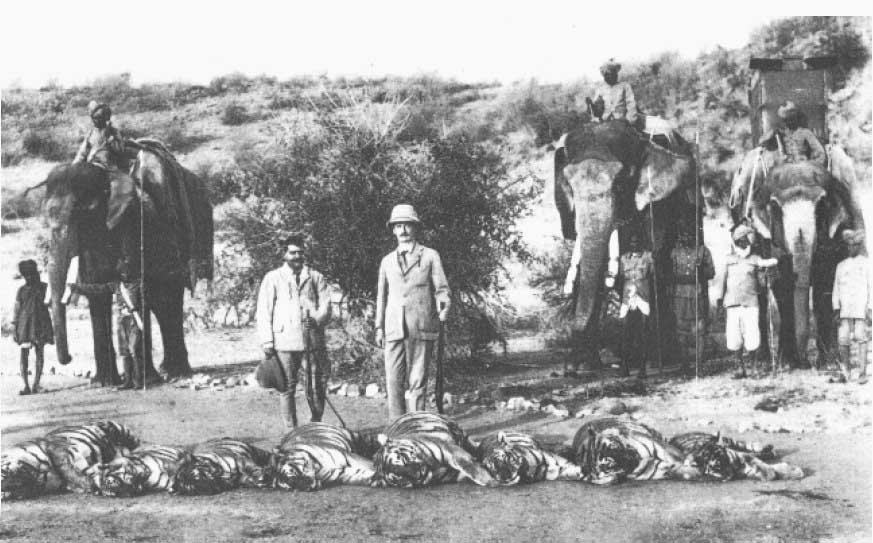
A Scottish trader, George Yule, killed more than 400 tigers during his time. Similarly, Lieutenant Colonel Geoffery Nightingale killed approximately 300 tigers. And many more hunters killed several tigers only for entertainment and to decorate their homes with the tiger skin.
Conservation Efforts
After independence, the new Indian governments faced a difficult challenge. To save the rapidly decreasing wildlife and to nurture them. The increasing human population and cutting down of jungles threatened the tigers.
Tigers’ hunting continued to fulfill the demand for tiger skin, claws, and canines in illegal markets. On the other hand, their protectors continued to be vigilant. In 1973 the Indian government made tigers the national animal and started Project Tiger for their conservation.
Current Status
Recently released the figures of the 5th cycle of India’s Tiger Census 2022, revealing a 6.7% increase in the tiger population over the past four years.
The census covered forested habitats in 20 states of India, with camera traps set up at 32,588 locations generating over 47 million photographs.
The current tiger population in India is 3,167, up from 2,967 in 2018. However, the growth rate has slowed to 6.7% from around 33% during 2014-2018.
Despite the recent increase in population the Bengal tiger is still listed as an endangered species by the International Union for Conservation of Nature (IUCN).
Watch Bengal Tiger
Conclusion
Even after being faced with many challenges, the conservation of the tiger in India showing positive signs. The love, respect, and contribution for wildlife is instilled in Indian culture as well as in Indian constitution.
FAQs
The Bengal tiger is named after the Bengal region in South Asia, where it is widely distributed. The name helps to distinguish it from other tiger subspecies.
The Bengal tiger is famous for its significant cultural importance, its majestic appearance, and its role as a symbol of wilderness and biodiversity. It is also the national animal of both India and Bangladesh.
While the Bengal tiger is indeed powerful and one of the largest tiger subspecies, the title of the most powerful often goes to the Siberian tiger, which is the largest.
The rarest tiger in India is the Golden Bengal Tiger, the White Bengal tiger and the Black Bengal Tiger.
The biggest tiger subspecies is the Siberian tiger, also known as the Amur tiger.
Yes, India is home to 70% of the world’s tiger population.




